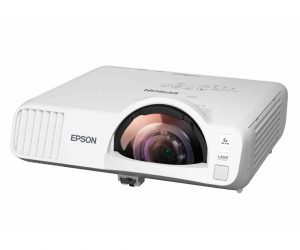
Classroom Acoustics
A critical, but challenging environment.
Text:\ Andrew Steel
As far as acoustics goes, the topics I’ve previously covered in these pages may have seemed tricky, but this one takes the cake – only read on if you like a real challenge!
Classroom acoustics requirements differ in many ways from the type of spaces we have already discussed such as churches, venues, boardrooms etc. One major difference is that the users of the space in all other instances will give feedback by either complaining or physically walking out. Students in a classroom, however, not only don’t have this option, but are highly unlikely to know there is something wrong. Teachers may raise the issue in very bad cases, but they are normally so overloaded with other things that acoustics just falls by the wayside. Tragically, the net effect of poor classroom acoustics is that the students are more likely to have trouble taking things in. This then, is probably the most important acoustic environment we should be working on improving. We put lots of effort into improving teaching practices, so surely we should include acoustics in the mix to keep up with the latest teaching methods.
Teaching in classrooms has changed over time and is now very different to when I was a student. The days of a teacher continuously ‘lecturing’ from the front of the room are over. Teaching from the front is still done, but teachers are much more likely to be walking around the room, interacting with students; as a whole, in small groups or as individuals. Classrooms are not only set up as rows of desks, but have group activity areas and more casual spaces like mats on the floor, to suit the type of activity. All sorts of media sources like television, computers, PA systems and projectors are used to support the teaching process. Quite obviously then, the acoustic requirements of a modern classroom are very different to those of the past. If we were trying to undertake a contemporary lesson in an old-style classroom, would it even work?
RETRO CAN BE COOL
As it turns out, it may actually be okay. Previously classrooms were constructed quite differently and, in fact, often had reasonable acoustics. The reason for this is that they had more absorbent surfaces like carpet and curtains – even timber floors and walls helped a little. Today, classrooms are made of concrete, plasterboard and glass, to make them cheaper to build and easier to maintain. This however makes them acoustically bright, shiny boxes, and the acoustic conditions inside them are less suitable for teaching. Even the sources of outside noise, which contribute negatively to the acoustics in a classroom, have in general increased over time. Oddly then, a quiet and less reverberant classroom of the past may well have worked well if they had a multimedia presentation! Even more odd is that despite the fact that we are now doing things that demand better acoustics, we have reduced the quality of acoustics in the modern classroom.
Since a large part of the learning and teaching process involves listening and speaking, acoustics will clearly play a significant part. Interfering noise will obviously make it harder for anyone to hear, but it causes fatigue as well. Excessive reverberation will reduce the level of speech intelligibility and contribute to the noise level. A combination of noise and poor acoustic conditions can create a situation worse than the simple sum of the two. Add to this the fact that younger children need much better listening conditions because they are not sufficiently cognitively developed to predict speech from context, and getting good acoustics in school environments becomes very important indeed.
PLEASE SIR: KEEP THE NOISE OUT
As with most acoustic situations, this comes down to minimising the entrance of external noise into the classroom, and creating good acoustic conditions inside the room. The sources of external noise are many in number and mostly quite obvious. They include traffic, other classrooms, sports/physical education classes, ground maintenance (like mowing and construction), plant and equipment (like air conditioners), footfall noise from rooms above, and even rain. Most of these are reasonably taken care of if the layout of the buildings can be optimised. Clearly this suits the construction of new schools and, in this case, simply keeping reasonable distances between noise sources and classrooms makes a big difference. Ensuring the sports areas and noisy areas like manual arts classrooms are far enough away, keeping plant like A/C behind barriers, and even keeping classrooms as separated as possible by hallways will all help.
In existing school buildings it gets a little more complicated as the noise source and receiver can’t be moved and barriers are rarely able to be constructed. For the ingress of noise to be reduced in existing buildings, the actual soundproofing of the structures themselves will have to be improved. This is relatively easy for walls, floors and ceilings and has been discussed in previous articles. Windows are a different story though. Unless the classroom is air conditioned, windows can’t always be closed – and an open window isn’t very soundproof. One option may be to use louvred vents that allow air to pass, but have some sound reduction capacity. Classrooms will almost certainly have opening windows, so some noise will always enter. The approach must be to minimise noise entering as well as minimising noise generated within the room.
PROBLEM: CHILDREN
Inside the classroom, there are some obvious noise sources, like the noise from excessive reverberation of students’ speech, and some less obvious ones like, computer fans, projectors, A/C, etc. These less obvious sources need to be minimised by either putting them in ventilated but silenced boxes or cupboards, or putting them in equipment rooms or equipment cupboards. Air conditioning systems can be made much quieter by design and such techniques are well known. It just needs to be prioritised at construction time. Once these sources are as minimised as they can be, we are left with the task of reducing the reverberation time in the room. This is important not only because long reverberation times decrease speech intelligibility, but because they also exacerbate the effect of noise sources.
Reducing the reverberation time inside a classroom follows the same rules as it does for other rooms of similar size, except that classrooms probably have less available space on which to apply absorption. It’s also a fairly safe bet that if you put an absorber with a nice soft surface on a wall in a classroom, someone will immediately pin stuff to it. As the surface of an absorber gets more covered in paper it obviously loses its effectiveness, so absorption on walls isn’t such a good idea. We also know from previous articles, that thin, pinboard-type material absorbs very little anyway. Bringing carpet back into the classroom would help, but the requirement for easy cleaning seems to prohibit this.
If you consider how much wall space is lost to windows and black or white boards, the only real option left is to put absorption on the ceiling – okay we have to rule out spit balls! The last 600mm or so at the top of the wall is a good place to put absorption because it has a slightly better low frequency performance when placed there. So absorption on the upper part of the wall and the ceiling is the best bet for reducing reverberation and improving speech intelligibility in a classroom. Of course, room shape and layout can help too, but limited to the design of new classrooms. Curtains or micro mesh-type blinds on the windows will add a little absorption as well, and although it isn’t a massive help, every little improvement is worth having.
PERFECT STORM
Classroom acoustics involve all of the issues we have explored in previous articles. The environment is probably more demanding than most though, because of the diversity of noise sources, the diversity of uses, the limited space and materials that can be used, and the highly critical role that speech and sound plays in the learning process, especially for younger children. It is very difficult to improve the acoustics of existing classrooms, especially if there are major noise sources outside or really bad reverberation issues in the room. In other words, soundproofing and acoustically treating an existing room would be tough because you can’t just move it to a quieter site or change how it is made or what it is made from. There are always things that can be done to make some improvements, like applying absorption to the ceiling; but ultimately, we need to make the acoustic design of all classrooms a high priority in the planning and construction.















RESPONSES